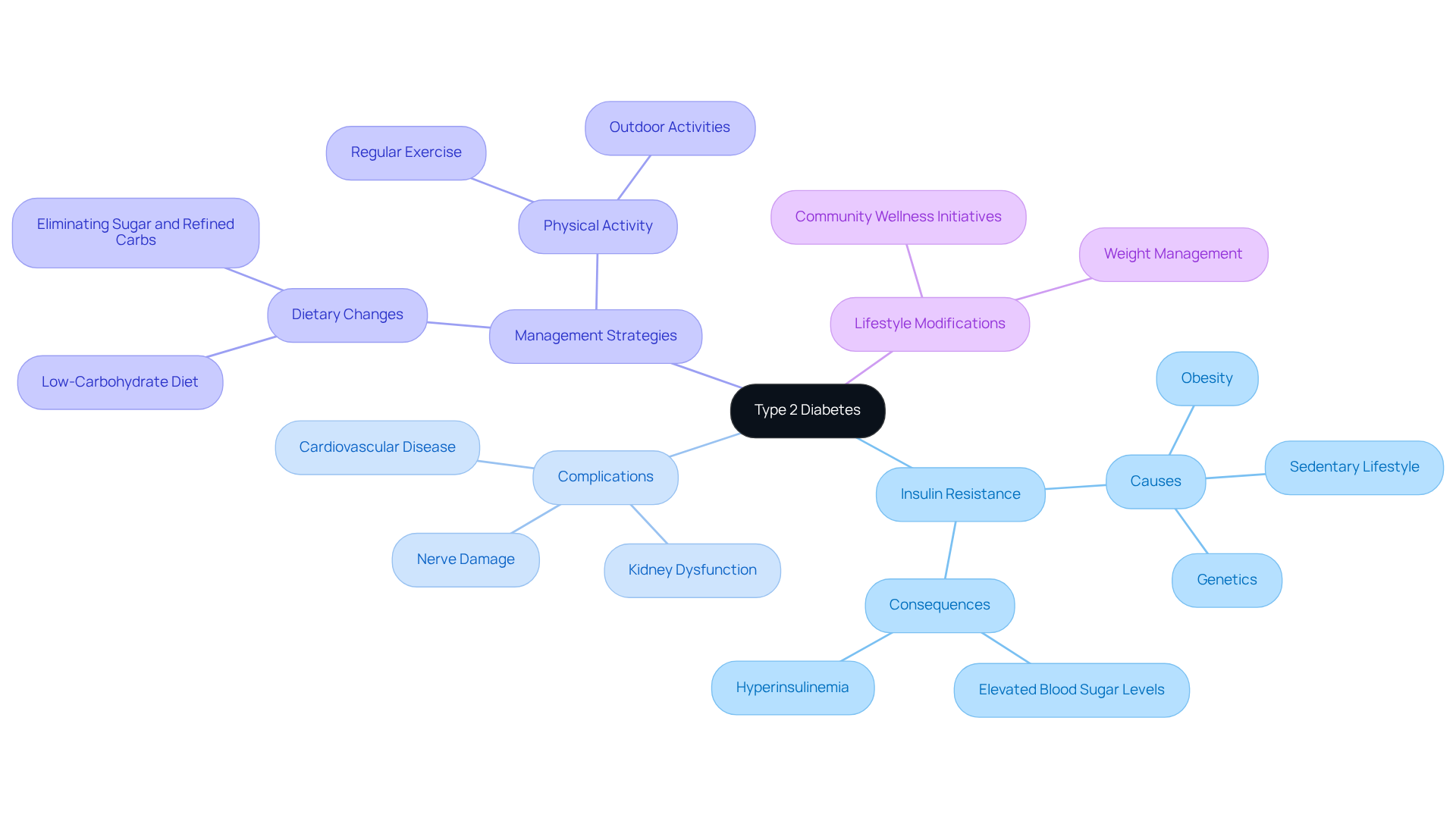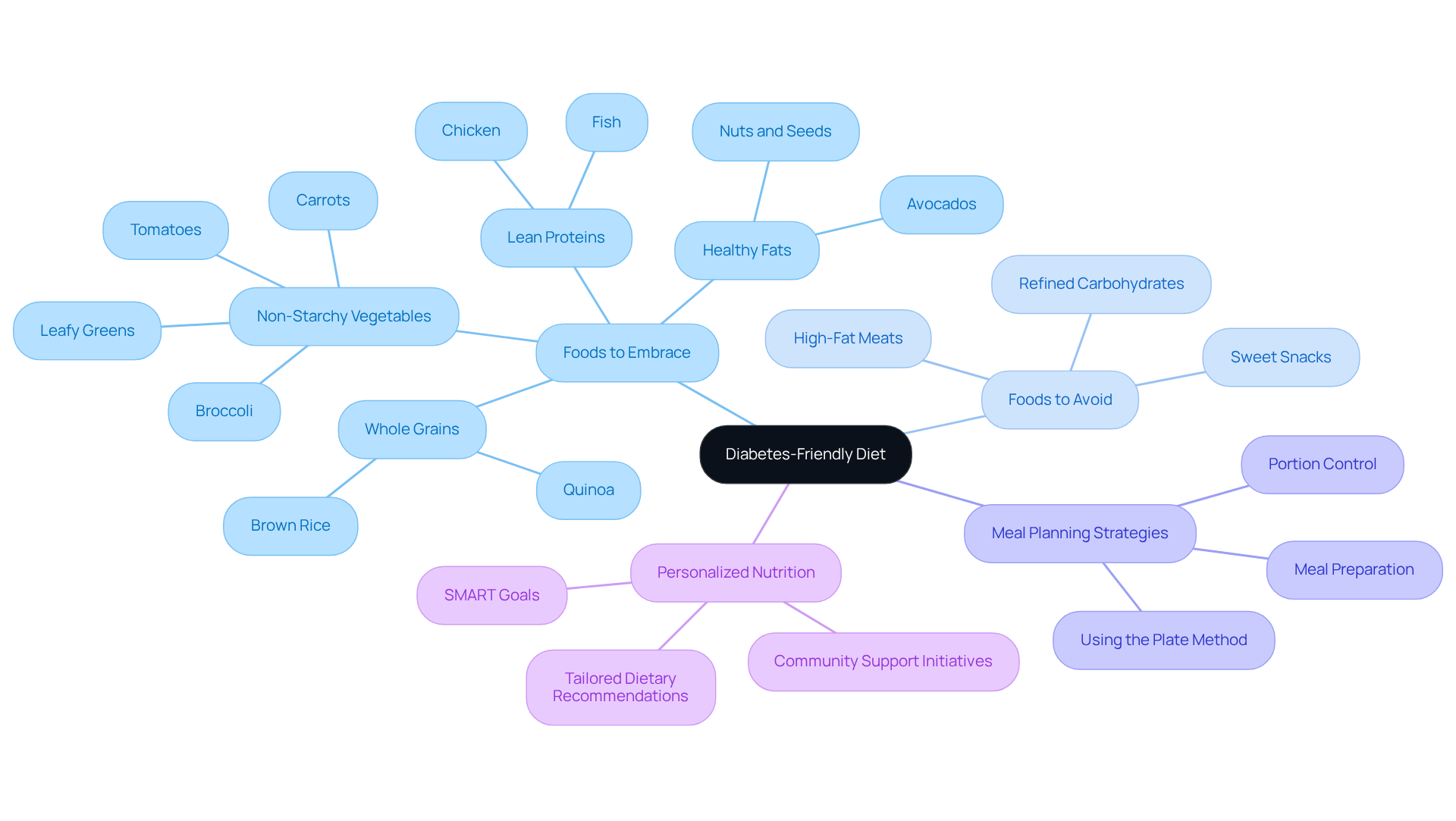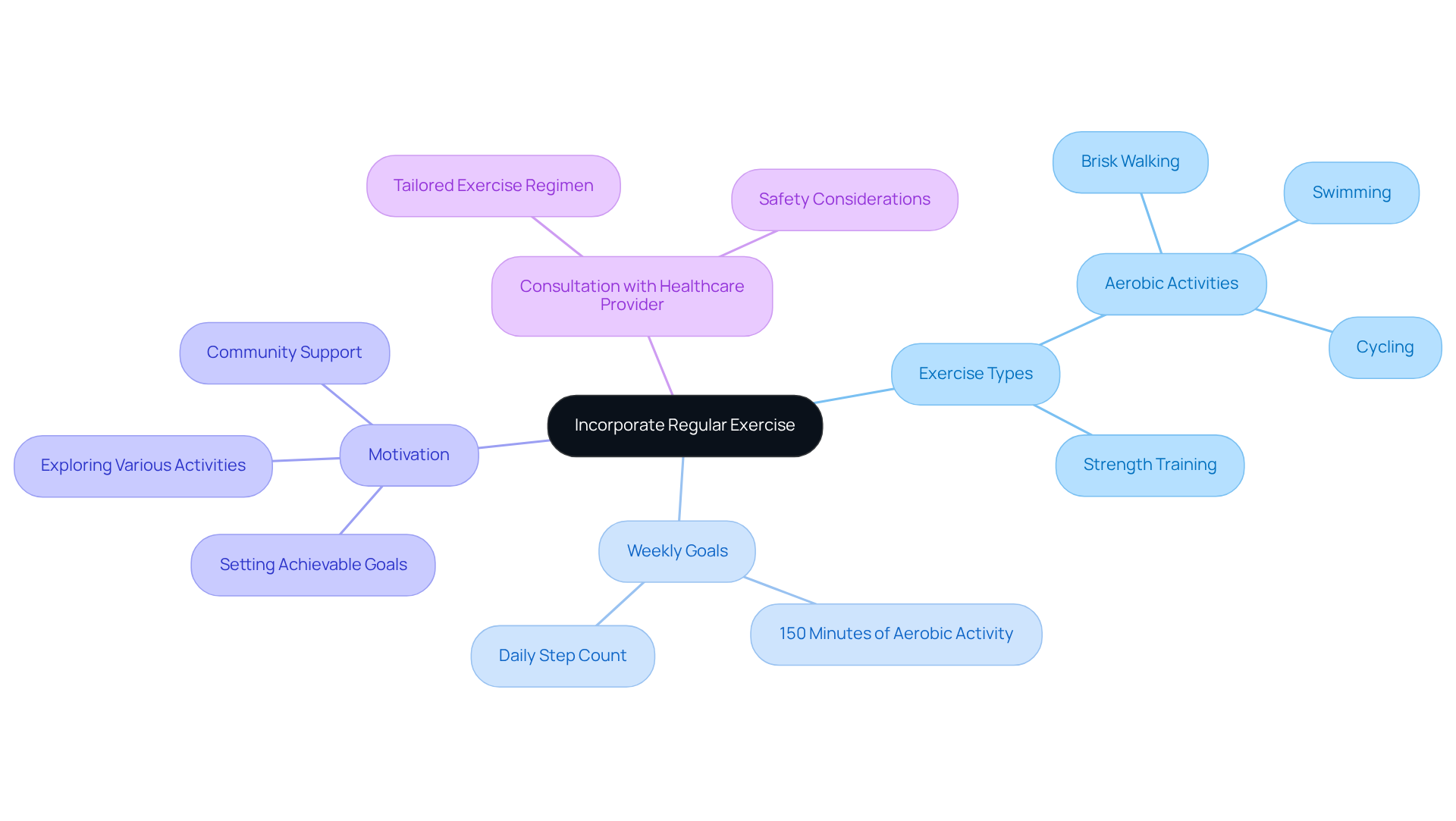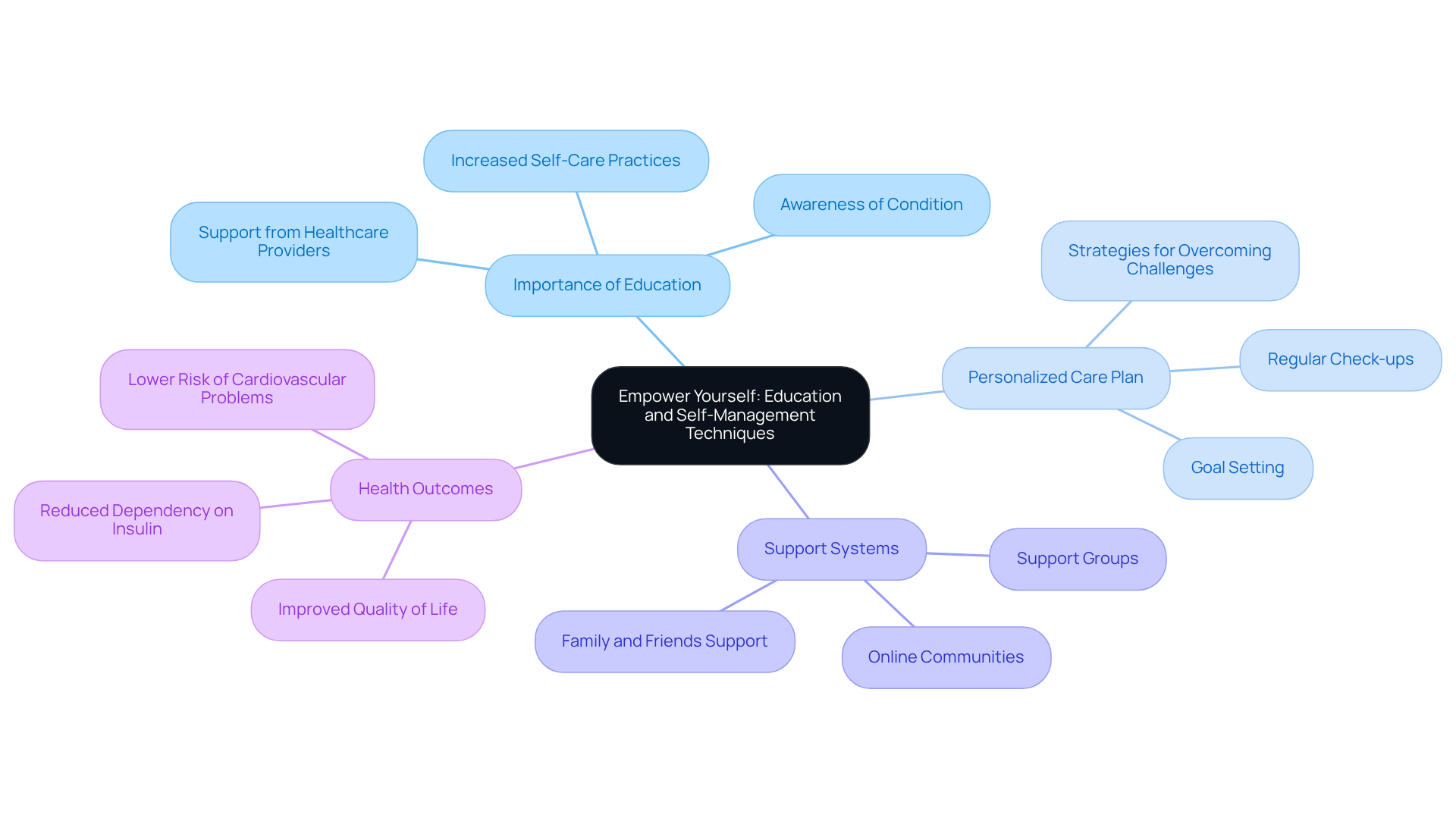Overview
For those navigating the challenges of Type 2 diabetes, there are four essential strategies that can truly make a difference in your journey.
- Consider adopting a diabetes-friendly diet that not only nourishes your body but also supports your health goals. It’s important to recognize that what you eat plays a crucial role in managing blood sugar levels.
- Incorporating regular exercise can be a powerful tool; many patients find that even small amounts of physical activity can lead to significant improvements in their well-being.
- Education is another vital aspect of empowerment. By educating yourself about diabetes, you can make informed choices that positively impact your life.
- Engaging with community support can also provide a sense of belonging and encouragement, reminding you that you are not alone in this journey.
Together, these strategies enhance blood sugar management and overall well-being.
Remember, adopting healthier lifestyle choices fosters accountability and provides the necessary resources and support for managing your condition. As you embark on this path, take heart in knowing that each step you take is a step toward a healthier future.
Introduction
Type 2 diabetes presents a complex challenge that affects millions of individuals, often leading to serious health complications if not managed effectively. It’s important to recognize that patients navigating this condition have a unique opportunity to transform their lives through informed lifestyle choices and proactive health strategies. However, with a plethora of information available, how can individuals discern the most essential practices that will empower them to thrive? Many patients find that focusing on key strategies can make a significant difference. This article delves into four pivotal strategies that not only enhance daily management of Type 2 diabetes but also foster a sense of agency and well-being among those affected.
Understand Type 2 Diabetes: Key Concepts and Implications
Type 2 diabetes patients are fundamentally characterized by insulin resistance, a condition where the body’s cells struggle to respond effectively to insulin, resulting in elevated blood sugar levels. This resistance can arise from various factors, including genetics, obesity, and a sedentary lifestyle. It’s important to recognize that understanding these mechanisms empowers patients to make informed choices about their well-being. Many patients find that weight management can significantly enhance insulin sensitivity, highlighting the crucial role of lifestyle modifications.
Type 2 diabetes patients must acknowledge the serious complications linked to unmanaged blood sugar levels, including:
- Cardiovascular disease
- Nerve damage
- Kidney dysfunction
These risks underscore the necessity for proactive management strategies, including dietary changes and regular physical activity, to improve overall health outcomes and quality of life for type 2 diabetes patients. In San Marcos, CA, adopting a holistic lifestyle can be a significant step in managing type 2 health conditions. Engaging in regular outdoor activities, such as hiking at Lake San Marcos or walking the trails at Discovery Lake, not only enhances physical fitness but also boosts mood and insulin sensitivity.
Additionally, focusing on a balanced diet rich in local produce, like avocados and berries, can help regulate blood sugar levels. Community wellness initiatives and local farmers’ markets offer vital assistance and resources, promoting a sense of connection and encouragement among individuals dealing with blood sugar issues. For personalized guidance and support tailored to your unique needs, consider reaching out to Dr. Jason Shumard in San Marcos, CA. Our expert team is dedicated to helping you navigate your diabetes management journey with care and expertise.
Implement a Diabetes-Friendly Diet: Foods to Embrace and Avoid
Managing diabetes can feel overwhelming at times, but a diabetes-friendly diet can truly make a difference. By emphasizing whole, nutrient-rich foods and reducing processed items and those high in sweetness, you can take significant steps toward better health. Focus on incorporating non-starchy vegetables, whole grains, lean proteins, and healthy fats into your meals. Leafy greens, quinoa, and fatty fish are not only delicious but also particularly beneficial choices for your wellbeing.
It’s important to recognize that steering clear of refined carbohydrates, sweet snacks, and high-fat meats is crucial, as these can lead to spikes in blood glucose levels. Many patients with type 2 diabetes find that effective meal planning significantly aids in diabetes management. For instance, preparing meals in advance can help you avoid impulsive, unhealthy choices when hunger strikes. Additionally, incorporating fiber-rich foods into your diet is essential; they slow digestion and improve feelings of fullness, aiding in better blood glucose management.
Recent trends also highlight the importance of personalized nutrition. Tailored dietary recommendations based on the individual needs of type 2 diabetes patients can further optimize blood sugar management. Establishing SMART goals—specific, measurable, attainable, relevant, and time-bound—can enhance your focus and motivation in managing your condition. For example, consider aiming to:
- Incorporate a certain number of servings of vegetables daily
- Plan to engage in physical activity for a set duration
These small steps can foster accountability and progress.
Participating in community wellness initiatives in San Marcos can provide invaluable support, offering resources and encouragement to help you reach your health objectives. To effectively monitor your progress, utilizing tracking methods such as fitness apps, journals, and pedometers is recommended. Regularly reviewing your progress allows you to adapt your goals as needed, ensuring you stay on track. Remember, you are not alone in this journey, and each step you take brings you closer to a healthier you.
Incorporate Regular Exercise: Strategies for Active Living
Integrating regular physical activity into everyday life is essential for enhancing blood sugar regulation in type 2 diabetes patients. It’s important to recognize that current guidelines recommend aiming for at least 150 minutes of moderate-intensity aerobic activity each week. This can include enjoyable activities like brisk walking, swimming, or cycling, which many find uplifting. Additionally, strength training exercises should be performed at least twice a week to build muscle mass, thereby enhancing insulin sensitivity. Many patients find that exploring various activities, such as group classes or outdoor sports, not only makes exercise enjoyable but also fosters a sense of community and support.
Setting achievable goals, such as a daily step count or a structured weekly workout schedule, can significantly boost motivation and adherence to an exercise routine. Have you ever noticed how type 2 diabetes patients who include regular physical activity in their diabetes management often report enhanced well-being and a stronger sense of empowerment? It is essential for patients to consult with their healthcare provider before starting any new exercise regimen to ensure it is safe and tailored to their individual needs. By embracing these strategies, individuals can take proactive steps toward better health and enhanced quality of life.
Empower Yourself: Education and Self-Management Techniques
Empowering yourself through education is not just important; it’s essential for effectively managing your condition. Have you ever felt overwhelmed by the complexities of your health? You’re not alone. Proactively seeking knowledge about your condition—like blood sugar monitoring, medication management, and recognizing the signs of hypo- or hyperglycemia—can make a significant difference. Many type 2 diabetes patients find that participating in self-management education programs related to their blood sugar conditions offers valuable insights and support. Research shows that type 2 diabetes patients involved in these programs are considerably more likely to follow suggested self-care practices.
It’s crucial to develop a personalized care plan tailored to the needs of type 2 diabetes patients. This plan should include:
- Regular check-ups
- Goal setting
- Strategies for overcoming challenges
Real-life stories, such as those of individuals who have successfully improved their well-being through customized strategies, truly highlight the effectiveness of this approach. Connecting with support groups or online communities can also foster a sense of belonging and provide the encouragement you need.
By taking charge of your health, you can markedly enhance your quality of life. Imagine shedding unwanted pounds, reducing your dependency on insulin, and lowering your risk of cardiovascular problems. This journey ultimately leads to better health outcomes. Remember, you’re not alone in this; support is available, and taking those first steps can lead to a brighter, healthier future.
Conclusion
Understanding and managing type 2 diabetes is indeed a multifaceted journey that many find challenging. It’s important to recognize that by embracing lifestyle modifications, patients can significantly enhance their health outcomes and overall quality of life. This article has outlined essential strategies designed to empower individuals to take control of their diabetes management, highlighting the critical role of education, diet, exercise, and self-management techniques.
Many patients find that a diabetes-friendly diet, which prioritizes whole foods while avoiding refined carbohydrates and sugary snacks, is a vital first step. Regular physical activity is equally important; engaging in both aerobic and strength training exercises can make a significant difference. Moreover, self-education and the establishment of personalized care plans are crucial for navigating the complexities of diabetes management. These strategies not only enhance insulin sensitivity but also foster a sense of community and support among patients.
Ultimately, the path to thriving with type 2 diabetes lies in embracing these strategies and seeking the necessary resources and support. By taking charge of one’s health through informed choices and consistent actions, individuals can pave the way for a healthier future. Engaging with local wellness initiatives, utilizing tracking methods, and connecting with healthcare professionals can further enrich this journey, ensuring that every step taken is a step toward better health and empowerment.
Remember, you are not alone in this; together, we can create a supportive environment that fosters your well-being.
Frequently Asked Questions
What is the fundamental characteristic of Type 2 diabetes?
Type 2 diabetes is fundamentally characterized by insulin resistance, where the body’s cells struggle to respond effectively to insulin, leading to elevated blood sugar levels.
What factors contribute to insulin resistance in Type 2 diabetes?
Insulin resistance in Type 2 diabetes can arise from various factors, including genetics, obesity, and a sedentary lifestyle.
Why is it important for patients to understand the mechanisms of Type 2 diabetes?
Understanding the mechanisms of Type 2 diabetes empowers patients to make informed choices about their well-being and management of the condition.
What are the serious complications linked to unmanaged blood sugar levels in Type 2 diabetes?
Serious complications linked to unmanaged blood sugar levels include cardiovascular disease, nerve damage, and kidney dysfunction.
What proactive management strategies can Type 2 diabetes patients adopt?
Proactive management strategies include dietary changes and regular physical activity to improve overall health outcomes and quality of life.
How can lifestyle modifications impact insulin sensitivity for Type 2 diabetes patients?
Weight management and engaging in regular physical activities can significantly enhance insulin sensitivity for Type 2 diabetes patients.
What local activities in San Marcos, CA, can help manage Type 2 diabetes?
Engaging in regular outdoor activities, such as hiking at Lake San Marcos or walking the trails at Discovery Lake, can enhance physical fitness and boost mood and insulin sensitivity.
What dietary focus can help regulate blood sugar levels for Type 2 diabetes patients?
A balanced diet rich in local produce, such as avocados and berries, can help regulate blood sugar levels.
How can community resources assist individuals managing Type 2 diabetes?
Community wellness initiatives and local farmers’ markets offer vital assistance and resources, promoting a sense of connection and encouragement among individuals dealing with blood sugar issues.
Where can patients find personalized guidance for managing Type 2 diabetes?
Patients can reach out to Dr. Jason Shumard in San Marcos, CA, for personalized guidance and support tailored to their unique needs in managing diabetes.



